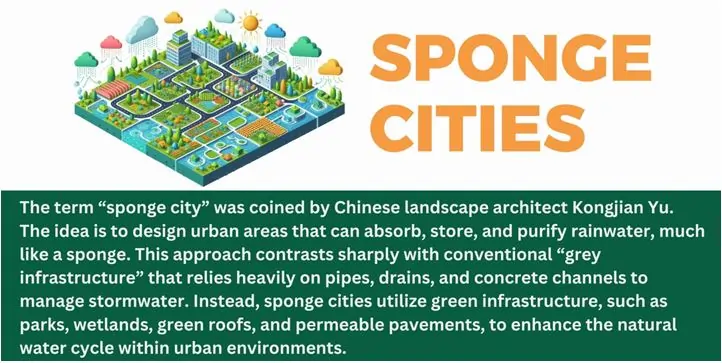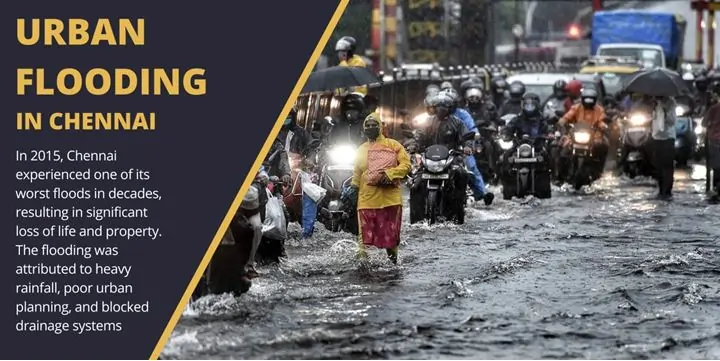
Flooding in urban areas is on the rise globally due to climate change and increased pace of urbanization. The current infrastructure in nations put into place is usually unable to deal with the rising level of rainfall seasonality, and so floods become devastating. However, there is an idea completely different from the usual approach to flooding, the so-called ‘sponge cities’. Sponge cities include a natural process in urban areas for effective flood water management and risk reduction in existing urban environments.
The Concept of Sponge Cities
The concept of sponge city has been introduced by Kongjian Yu, the Chinese landscape architect. The thinking is that one has to create structures that surround these rainwater systems and enable them to soak like a sponge. This approach is significantly different from the usual ‘grey infrastructure’ which uses pipes, drains and the concrete channels. However, sponge cities allow the natural water cycle procedures like natural retention basins, parks, wetlands, and green roofs, and permeable pavements.
How Sponge Cities Work
It includes the various methods to absorb the water and manage rain water some of these include:
- Green Spaces: Meaning, parks, gardens, green roofs, or some type of sturdy plants can actually catch water and thus minimize run-off, and therefore increase the re-charge of the water table.
- Permeable Surfaces: Use of permeable surfaces like sidewalksor pavements allows water to penetrate through to the ground rather than washing of water on the surface resulting to floods.
- Wetlands and Ponds: These natural or artificial water bodies serve as receptacles by holding excessive water from rain and gradually discharging the same into the atmosphere.
- Rain Gardens and Bioswales: They are green pavement areas intended for infiltration and treatment of storm-water and retention of pollutants.
They are able to reduce the effects of intense precipitation; prevent flooding events; and improve water quality.

Benefits of Sponge Cities
Sponge city functions are not limited to the roles they play in flood control. They also contribute to:
- Improved Water Quality: Through the natural processes, sponge cities management of storm water inhibits the flows of pollutants into the water bodies such as rivers and lake.
- Enhanced Biodiversity: Will improve on Green space& Wetlands that provides plant &Animal natural breeding grounds to increase urban biodiversity.
- Climate Resilience: Sponge cities are more capable of adapted extreme weather conditions such as flooding through intense rain falls and heat through heat waves hence more able to withstand climate change impacts.
- Aesthetic and Recreational Value: Green infrastructure beautifies the human environment and provides leisure for the residents.
Case Studies
Currently, many geographical regions across the globe have embraced the sponge city concept with word-class results. For example, Wuhan in China has particularly many green infrastructure works such as park, wetland, permeable pavement to overcome the problems of storm water and flooding. Likewise, Copenhagen, Denmark, has a plan that is aiming at achieving a sponge city status by 2030 through putting into practice green roof, rain gardens among other permeable surfaces in the city.
How sponge cities help to control floods?
Sponge cities reduce flooding by integrating natural procedures into city planning. Some of these are mentioned here:
- Absorption and Infiltration: Sponge city reduces water flow by using parks, gardens and green walls or roofs to manage the excess water. Urbanization increases the construction of impervious surfaces which include pavements, sidewalks, roads, parking lots and commercial spaces; through permeable pavements the water penetrates the ground preventing flooding.
- Storage and Slow Release: Retention structures include wetlands, ponds, and rain gardens collect rainfall in excess and slowly release it into the environment. This assists in controlling the amount of water in case of intense rainfall and thereby avoiding rapid flooding.
- Filtration and Purification: Rain gardens and Bioswales are used in this case with the principal aim of filtering and slowing down stormwater and preventing pressure on it. It is not only useful in flood control but water quality as well.
- Groundwater Recharge: By use of the green covers and impervious surfaces ground water gets recharged. This contributes to natural water cycle and minimizes the calamities brought by flooding.
- Enhanced Drainage Systems: Sponge cities add green infrastructure to the conventional stormwater system to improve its functionality. This combined approach affords maximum control on excess water avoiding its accumulation in the urban centres.
Major sources of the urban floods
- Heavy Rainfall: Continuous and heavy rainfall tends to load the existing urban drainage structures, which results in flooding. This is usually compounded by climate change, given that there is increased instances and severity of the event of heavy rains.
- Impermeable Surfaces: Gardens, playgrounds and lawns as well as urban structures like roads, pavements, and buildings discourage any passage of water into the ground. This results to enhanced surface runoff and enhanced flood hazards.
- Inadequate Drainage Systems: Unfortunately, most cities’ drainage systems are inadequate or old state and cannot deal with high volumes of water in the form of storms. Other causes of flooding include blocked or poorly maintained drainpipes.
- Poor Land Use Planning: Erosion or filling of natural water bodies, wetlands and flood plains limits accommodation of water on the land. Flooring also becomes an issue through unauthorised construction and expansion of built-up areas.
- River Overflow: Runoff is the major cause of urban floods since rivers and streams after being full can overflow during rains or snow meltage. This is especially typical in regions that lack basic flood protection structures.
- Deforestation and Loss of Vegetation: Cutting trees and vegetation erases the land’s capacity for water retention and causes higher levels of surface water runoff and flooding. Such development intensifies deforestation, and the loss of such essential features as green spaces in urban areas.
- Climate Change: The occurrence of urban flooding is closely related to both heavier rainfall due to climate change and increased sea/river levels.
Conclusion
Sponge cities refer to urban floods management strategies that use natural processes in developing sustainable cities. The inclusion of green infrastructure within the concept of sustainable cities allows improving the effects and impacts of climate change, including storm water control and flood risks minimization for citizens.In the contemporary globalized world, climate change and urban sprawl present inevitable negatives faced by the modern city; sponge cities may provide novel positive methods for the future.
Urban Floods and India: A Growing Challenge
Flood is a severe concern in the urban environment of the country and has been causing severe impact on many cities in the country in recent years. Such occurrence is as a result of a set of endogenous and exogenous conditions such as climate change, increased rate of urbanization, and poor infrastructure. It is important that cities gather knowledge of the causes, effects and mitigation measures of urban floods in order to design better and sustainable cities.
Causes of urban flood in India
- Monsoon rain: One of the major reasons that cause floods in urban areas is prolonged and heavy precipitation during Monsoon. The monsoon season relevant for the Indian agriculture can produce severe floods in urban areas when the amount of water overwhelms down the drainage system.
- Concrete Surfaces: Due to increased urbanization, the surfaces are mainly concrete pavements, roads and buildings which increase the runoff volume. These surfaces do not allow water to seep into the ground to reduce surface water thus deepening floods.
- Poor Drainage management: Most urban Indian cities either have inadequate or have poorly developed drainage systems that cannot manage the runoff water during rainy seasons. The situation worsens when drains are blocked or poorly maintained and results in water logging and flooding.
- Encroachment: There is the increased loss of ecological networks,particularly wetland that suffer from the effects of rapid urbanization. It also affects the soil structure and capacity to handle water hence likely to be flooded most of the times.
- Climate Change: Adverse impacts of climate change have also been witnessed especially in enhanced precipitation regimes such as increased and frequent rainfall.
Impacts of Urban Flooding
Urban flooding has far-reaching impacts on cities and their residents:
- Damage to Infrastructure: Floods can wash away roads, bridges and any other structures for example, buildings made of either concrete or by other materials. This also gives high repair costs while also affecting transport and communication infrastructure.
- Economic Losses: Rainfall burst and flooding do cause significant losses in terms of damages, social and economic losses such as losses in business, disruptions of economic activities, etc. These costs are very expensive to recover let along rebuild, they put lots of pressure on local and national economies.
- Health Risks: The water that comes with floods is also containing pollutants and organisms that are deadly to human beings. Flood water is a perfect breeding ground for bacteria’s such as cholera and dysentery and other water borne diseases.
- Displacement of People: The worst-case scenario is that there may be a massive loss of people’s homes that it causes people to temporarily or permanently lose their shelter.
- Environmental Degradation: Flooding may cause issues of water borne diseases, loss of farmland, depredation of natural resources, and coastal and riparian land destruction. It can have long-term consequences and has the potential to harm local environments, and species composition and distribution.
Case studies on urban flood in India
Several Indian cities have experienced severe urban flooding in recent years:
- Mumbai: It is one of the most developed cities of India and the city has had several floods within a relatively short span of time; the worst being in the year 2005. Lack of proper drainage and web development, hence retardation of natural water ways have been some of the leading causes.
- Hyderabad: Hyderabad experienced very bad rains in October 2020 due to which there was a great flood that impacted many people. Poor drainage system and the fast growth of the city were the main causes.

Conclusion and Recommendation
Addressing urban flooding in India requires a multi-faceted approach:
- Improved Urban Planning: The institutions must realise that the developed cities must integrate flood management in urban development plans. It includes protection of water sources, water shedding areas and avoiding putting up infrastructures in water sources areas.
- Upgrading Drainage Systems: Storm water management is well done when there is direct investment in proper and well-developed drainage systems. Drain cares and cleaning also minimize drain blockages and flooding in facilities or working areas as well.
- Green Infrastructure: Using vegetation especially within parklands, rooftop gardens or parking lots with permeable pavements to filter rainwater can immensely assist in controlling the levels of surface run-off. This strategy has been used in several cities around the world.
- Early Warning Systems: Evaluation of flood earlywarning systems plays an important role in flood control and management within cities. These include tracking of weather conditions as they happen and passing information on the same to the affected residents.
- Community Engagement: Flood management calls for the involvement of local communities. This means that raising public awareness on flood risks and engaging the residents in planning and preparedness can improve community based flood resilience.